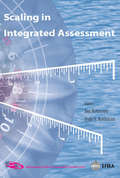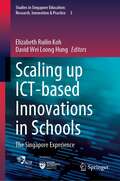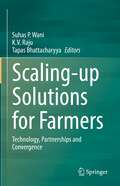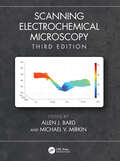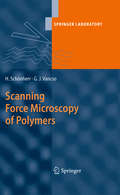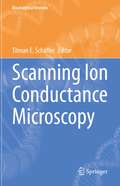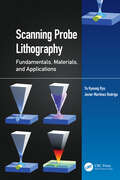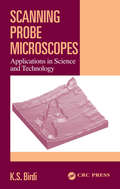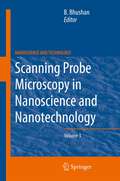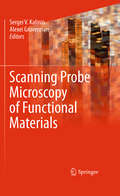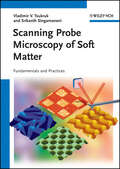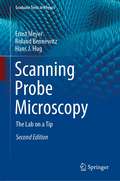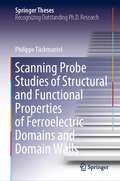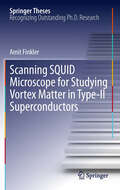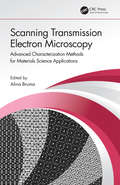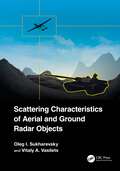- Table View
- List View
Scaling in Integrated Assessment
by Dale S. Rothman Jan RotmansA collection of papers prepared for the European Forum on Integrated Environmental Assessment's (EFIEA) Policy Workshop on Scaling Issues in Integrated Assessment, held from 12-19 July 2000.
Scaling up ICT-based Innovations in Schools: The Singapore Experience (Studies in Singapore Education: Research, Innovation & Practice #3)
by Elizabeth Ruilin Koh David Wei Loong HungThis collected book is about the eduLab projects, an initiative with focus on Scaling Change through Apprenticising and Ecological Leadership, designed to surface and spread ground-up information and communication technology-based pedagogical innovations. It presents the goals and rationale behind eduLab, an overview of the research projects conducted by its principal investigators during its funding tenure, as well as synthesizing thoughts on the entire endeavor. This book not only marks the achievements of the eduLab programme but also serves as inspiration for future projects. It presents Singapore education in action – a continually evolving and adapting education system that delivers a system well known for its high quality as much as it is forward-looking.
Scaling-up Solutions for Farmers: Technology, Partnerships and Convergence
by Tapas Bhattacharyya K. V. Raju Suhas P. WaniThis book provides a unique account of cross-sectoral innovations through efficient partnerships based on the hands-on experience of internationally renowned contributors specialised in the field of Science of Delivery. The challenges and lessons learned from large development initiatives based in Asia, and from the work undertaken by international research institutions, such as the FAO, are brought together in this book to benefit development agencies, policy makers, corporates, post graduate students, farmers’ organizations, and those involved in supplying agricultural inputs and/or buying agricultural produce, particularly in developing countries within Asia and Africa. Through a number of case studies the book describes how the consortium approach of capacity building for equitable and efficient benefits, collective action, and convergence, will benefit millions of small farm-holders in different regions of Asia
Scanning Electrochemical Microscopy
by Allen J. BardBecause of its simplicity of use and quantitative results, Scanning Electrochemical Microscopy (SECM) has become an indispensable tool for the study of surface reactivity. The fast expansion of the SECM field over several years has been fueled by the introduction of new probes, commercially available instrumentation, and new practical applications. Scanning Electrochemical Microscopy, Third Edition offers essential background and in-depth overviews of specific applications in self-contained chapters. The vitality and growing popularity of SECM over the past 30+ years have largely been determined by its versatility and capability to remain useful in the changing scientific and technological environments. New applications reported during the last decade reflect significant current activity in biomedical and energy-related research. This thoroughly updated edition provides up-to-date comprehensive reviews of different aspects of SECM. New chapters by renowned professionals in the field cover recent advances in different areas of SECM including nanoSECM, surface reactions and films, batteries, and fuel cells. Expanded coverage of electrocatalysis and surface interrogation as well as photoelectrochemistry and photoelectrocatalysis are also provided. Useful for a broad range of interdisciplinary research—from biological systems to nanopatterning—this book is invaluable to all interested in learning and applying SECM.
Scanning Force Microscopy of Polymers
by Holger Schönherr G. Julius VancsoThis lab manual introduces the reader to scanning force microscopy of polymers based on a practice-oriented approach. It begins with a broad introduction to the necessary background of SFM, including intermolecular forces and various SFM imaging modes. "Scanning Force Microscopy of Polymers" is developed in a didactically clear and easily understandable style. The application of SFM to visualize and study polymers is exemplified by numerous case studies, including experimental protocols. In addition, the book helps the reader to develop a conscious and critical understanding of SFM data. This approach enables the reader to acquire the knowledge and experimental skills that are necessary to understand and obtain good and reliable SFM results within the shortest time possible.
Scanning Ion Conductance Microscopy (Bioanalytical Reviews #3)
by Tilman E. SchäfferThis book provides a selection of recent developments in scanning ion conductance microscopy (SICM) technology and applications. In recent years, SICM has been applied in an ever-increasing number of areas in the bioanalytical sciences. SICM is based on an electrolyte-filled nanopipette with a nanometer-scale opening, over which an electric potential is applied. The induced ion current is measured, which allows to directly or indirectly quantify various physical quantities such as pipette-sample distance, ion concentration, sample elastic modulus among many others. This makes SICM well suited for applications in electrolytes - most prominently for the study of live cells.This book starts with a historic overview starting from the days of the invention of SICM by Paul Hansma at the University of California at Santa Barbara in 1989. SICM is a member of the family of scanning probe microscopies. It is related to another prominent member of the family, atomic force microscopy (AFM), which has found application in almost any field of nanoscale science. The advantages and disadvantages of SICM over AFM are also outlined. One of the most effective and break-through applications of SICM nanopipettes is in electrochemistry. The different routes and applications for doing electrochemistry using nanopipettes are also discussed. In addition the book highlights the ability of SICM for surface positioning with nanometer precision to open up new vistas in patch clamp measurements subcellular structures. Finally the book presents one research area where SICM has been making a lot of contributions, cardiac research and the endeavors to combine SICM with super-resolution optical microscopy for highest-resolution joint topography and functional imaging.
Scanning Probe Lithography: Fundamentals, Materials, and Applications (Emerging Materials and Technologies)
by Yu Kyoung Ryu Javier Martinez RodrigoThe most complete book available on scanning probe lithography (SPL), this work details the modalities, mechanisms, and current technologies, applications, and materials on which SPL can be performed. It provides a comprehensive overview of this simple and cost-effective technique, which does not require clean room conditions and can be performed in any lab or industry facility to achieve high-resolution and high-quality patterns on a wide range of materials: biological, semiconducting, polymers, and 2D materials. • Introduces historical background of SPL, including evolution of the technique and tools • Explains the mechanism of sample modification/manipulation, types of AFM tips, technical parts of the experimental setup, and materials on which the technique can be applied • Shows the different types of devices and structures fabricated by SPL, together with the processing steps • Contains a complete and state-of-the art package of examples and different approaches, performed by different international research groups • Summarizes strengths, limitations, and potential of SPL This book is aimed at advanced students, technicians, and researchers in materials science, microelectronics, and others working with lithographic techniques and fabrication processes.
Scanning Probe Microscopes: Applications in Science and Technology
by K. S. BirdiScanning Probe Microscopes: Applications in Science and Technology explains, analyzes, and demonstrates the most widely used microscope in the family of microscopes -- the scanning probe microscope. Beginning with an introduction to the development of SPMs, the author introduces the basics of scanning tunneling and atomic force microscopes (STMs an
Scanning Probe Microscopy in Nanoscience and Nanotechnology 3
by Bharat BhushanThis book presents the physical and technical foundation of the state of the art in applied scanning probe techniques. It constitutes a timely and comprehensive overview of SPM applications. The chapters in this volume relate to scanning probe microscopy techniques, characterization of various materials and structures and typical industrial applications, including topographic and dynamical surface studies of thin-film semiconductors, polymers, paper, ceramics, and magnetic and biological materials. The chapters are written by leading researchers and application scientists from all over the world and from various industries to provide a broader perspective.
Scanning Probe Microscopy of Functional Materials
by Sergei V. Kalinin Alexei GruvermanThe goal of this book is to provide a general overview of the rapidly developing field of novel scanning probe microscopy (SPM) techniques for characterization of a wide range of functional materials, including complex oxides, biopolymers, and semiconductors. Many recent advances in condensed matter physics and materials science, including transport mechanisms in carbon nanostructures and the role of disorder on high temperature superconductivity, would have been impossible without SPM. The unique aspect of SPM is its potential for imaging functional properties of materials as opposed to structural characterization by electron microscopy. Examples include electrical transport and magnetic, optical, and electromechanical properties. By bringing together critical reviews by leading researchers on the application of SPM to to the nanoscale characterization of functional materials properties, this book provides insight into fundamental and technological advances and future trends in key areas of nanoscience and nanotechnology.
Scanning Probe Microscopy of Soft Matter: Fundamentals and Practices
by Vladimir V. Tsukruk Srikanth SingamaneniWell-structured and adopting a pedagogical approach, this self-contained monograph covers the fundamentals of scanning probe microscopy, showing how to use the techniques for investigating physical and chemical properties on the nanoscale and how they can be used for a wide range of soft materials. It concludes with a section on the latest techniques in nanomanipulation and patterning. This first book to focus on the applications is a must-have for both newcomers and established researchers using scanning probe microscopy in soft matter research. From the contents: * Atomic Force Microscopy and Other Advanced Imaging Modes * Probing of Mechanical, Thermal Chemical and Electrical Properties * Amorphous, Poorly Ordered and Organized Polymeric Materials * Langmuir-Blodgett and Layer-by-Layer Structures * Multi-Component Polymer Systems and Fibers * Colloids and Microcapsules * Biomaterials and Biological Structures * Nanolithography with Intrusive AFM Tipand Dip-Pen Nanolithography * Microcantilever-Based Sensors
Scanning Probe Microscopy: The Lab on a Tip (Graduate Texts in Physics)
by Ernst Meyer Roland Bennewitz Hans J. HugWritten by three leading experts in the field, this textbook describes and explains all aspects of the scanning probe microscopy. Emphasis is placed on the experimental design and procedures required to optimize the performance of the various methods. Scanning Probe Microscopy covers not only the physical principles behind scanning probe microscopy but also questions of instrumental designs, basic features of the different imaging modes, and recurring artifacts. The intention is to provide a general textbook for all types of classes that address scanning probe microscopy. Third year undergraduates and beyond should be able to use it for self-study or as textbook to accompany a course on probe microscopy. Furthermore, it will be valuable as reference book in any scanning probe microscopy laboratory. Novel applications and the latest important results are also presented, and the book closes with a look at the future prospects of scanning probe microscopy, also discussing related techniques in nanoscience. Ideally suited as an introduction for graduate students, the book will also serve as a valuable reference for practising researchers developing and using scanning probe techniques.
Scanning Probe Microscopy¿in Industrial Applications: Nanomechanical Characterization
by Dalia G. YablonDescribes new state-of-the-science tools and their contribution to industrial R&D With contributions from leading international experts in the field, this book explains how scanning probe microscopy is used in industry, resulting in improved product formulation, enhanced processes, better quality control and assurance, and new business opportunities. Readers will learn about the use of scanning probe microscopy to support R&D efforts in the semiconductor, chemical, personal care product, biomaterial, pharmaceutical, and food science industries, among others. Scanning Probe Microscopy in Industrial Applications emphasizes nanomechanical characterization using scanning probe microscopy. The first half of the book is dedicated to a general overview of nanomechanical characterization methods, offering a complete practical tutorial for readers who are new to the topic. Several chapters include worked examples of useful calculations such as using Hertz mechanics with and without adhesion to model a contact, step-by-step instructions for simulations to guide cantilever selection for an experiment, and data analysis procedures for dynamic contact experiments. The second half of the book describes applications of nanomechanical characterization in industry, including: New formulation development for pharmaceuticals Measurement of critical dimensions and thin dielectric films in the semiconductor industry Effect of humidity and temperature on biomaterials Characterization of polymer blends to guide product formulation in the chemicals sector Unraveling links between food structure and function in the food industry Contributions are based on the authors' thorough review of the current literature as well as their own firsthand experience applying scanning probe microscopy to solve industrial R&D problems. By explaining the fundamentals before advancing to applications, Scanning Probe Microscopy in Industrial Applications offers a complete treatise that is accessible to both novices and professionals. All readers will discover how to apply scanning probe microscopy to build and enhance their R&D efforts.
Scanning Probe Studies of Structural and Functional Properties of Ferroelectric Domains and Domain Walls (Springer Theses)
by Philippe TückmantelThis thesis explores the fascinating properties of domain walls in ferroelectric materials. Domain walls can be used as model systems to study fundamental aspects of interface physics, such as crackling noise, with implications extending to a broad variety of systems, from material fracture and earthquakes to solar flares and collective decision making. Ferroelectric domain walls also show functional properties absent from the domains themselves, such as enhanced conduction leading to the tantalizing possibility of reconfigurable nanoelectronic circuitry where domain walls are active components. This work discusses the crackling physics of domain walls in thin films of Pb(Zr0.2Ti0.8)O3, as well as links between the local conductivity of domain walls and nanoscale geometrical distortions due to defects, and discusses unusual polarization textures with rotational components at crossings of ferroelastic twin domains. The results presented in this thesis have important implications for the experimental study of crackling systems.
Scanning SQUID Microscope for Studying Vortex Matter in Type-II Superconductors
by Amit FinklerCommon methods of local magnetic imaging display either a high spatial resolution and relatively poor field sensitivity (MFM, Lorentz microscopy), or a relatively high field sensitivity but limited spatial resolution (scanning SQUID microscopy). Since the magnetic field of a nanoparticle or nanostructure decays rapidly with distance from the structure, the achievable spatial resolution is ultimately limited by the probe-sample separation. This thesis presents a novel method for fabricating the smallest superconducting quantum interference device (SQUID) that resides on the apex of a very sharp tip. The nanoSQUID-on-tip displays a characteristic size down to 100 nm and a field sensitivity of 10^-3 Gauss/Hz^(1/2). A scanning SQUID microsope was constructed by gluing the nanoSQUID-on-tip to a quartz tuning-fork. This enabled the nanoSQUID to be scanned within nanometers of the sample surface, providing simultaneous images of sample topography and the magnetic field distribution. This microscope represents a significant improvement over the existing scanning SQUID techniques and is expected to be able to image the spin of a single electron.
Scanning Technologies for Autonomous Systems
by Oleg Sergiyenko Wendy Flores-Fuentes Julio C. Rodríguez-Quiñonez Moises J. Castro-ToscanoThis book provides the theory, methodology, and uses of scanning technologies for the application of autonomous systems. The authors provide readers with an understanding of different technologies and methods to perform scanning technologies and their optimal application depending on the kind of autonomous system. Also, the book presents a compilation of original high-quality contributions and research results from worldwide authors on emerging new autonomous systems based on different scanning technologies. This book is a valuable reference for engineering professionals and the scientific community.
Scanning Transmission Electron Microscopy
by Stephen J. Pennycook Peter D. NellistScanning transmission electron microscopy has become a mainstream technique for imaging and analysis at atomic resolution and sensitivity, and the authors of this book are widely credited with bringing the field to its present popularity. Scanning Transmission Electron Microscopy(STEM): Imaging and Analysis will provide a comprehensive explanation of the theory and practice of STEM from introductory to advanced levels, covering the instrument, image formation and scattering theory, and definition and measurement of resolution for both imaging and analysis. The authors will present examples of the use of combined imaging and spectroscopy for solving materials problems in a variety of fields, including condensed matter physics, materials science, catalysis, biology, and nanoscience. Therefore this will be a comprehensive reference for those working in applied fields wishing to use the technique, for graduate students learning microscopy for the first time, and for specialists in other fields of microscopy.
Scanning Transmission Electron Microscopy: Advanced Characterization Methods for Materials Science Applications
by Alina BrumaScanning Transmission Electron Microscopy is focused on discussing the latest approaches in the recording of high-fidelity quantitative annular dark-field (ADF) data. It showcases the application of machine learning in electron microscopy and the latest advancements in image processing and data interpretation for materials notoriously difficult to analyze using scanning transmission electron microscopy (STEM). It also highlights strategies to record and interpret large electron diffraction datasets for the analysis of nanostructures. This book: Discusses existing approaches for experimental design in the recording of high-fidelity quantitative ADF data Presents the most common types of scintillator-photomultiplier ADF detectors, along with their strengths and weaknesses. Proposes strategies to minimize the introduction of errors from these detectors and avenues for dealing with residual errors Discusses the practice of reliable multiframe imaging, along with the benefits and new experimental opportunities it presents in electron dose or dose-rate management Focuses on supervised and unsupervised machine learning for electron microscopy Discusses open data formats, community-driven software, and data repositories Proposes methods to process information at both global and local scales, and discusses avenues to improve the storage, transfer, analysis, and interpretation of multidimensional datasets Provides the spectrum of possibilities to study materials at the resolution limit by means of new developments in instrumentation Recommends methods for quantitative structural characterization of sensitive nanomaterials using electron diffraction techniques and describes strategies to collect electron diffraction patterns for such materials This book helps academics, researchers, and industry professionals in materials science, chemistry, physics, and related fields to understand and apply computer-science–derived analysis methods to solve problems regarding data analysis and interpretation of materials properties.
Scarcity and Growth Revisited: Natural Resources and the Environment in the New Millenium
by Robert U. Ayres R. David Simpson Michael A. TomanIn this volume, a group of distinguished international scholars provides a fresh investigation of the most fundamental issues involved in our dependence on natural resources. In Scarcity and Growth (RFF, 1963) and Scarcity and Growth Reconsidered (RFF, 1979), researchers considered the long-term implications of resource scarcity for economic growth and human well-being. Scarcity and Growth Revisited examines these implications with 25 years of new learning and experience. It finds that concerns about resource scarcity have changed in essential ways. In contrast with the earlier preoccupation with the adequacy of fuel, mineral, and agricultural resources and the efficiency by which they are allocated, the greatest concern today is about the Earth?s limited capacity to handle the environmental consequences of resource extraction and use. Opinion among scholars is divided on the ability of technological innovation to ameliorate this 'new scarcity.' However, even the book?s more optimistic authors agree that the problems will not be successfully overcome without significant advances in the legal, financial, and other social institutions that protect the environment and support technical innovation. Scarcity and Growth Revisited incorporates expert perspectives from the physical and life sciences, as well as economics. It includes issues confronting the developing world as well as industrialized societies. The book begins with a review of the debate about scarcity and economic growth and a review of current assessments of natural resource availability and consumption. The twelve chapters that follow provide an accessible, lively, and authoritative update to an enduring-but changing-debate.
Scarecrow and the Army of Thieves
by Matthew ReillyTHE ULTIMATE HERO IS BACKTHE WORLD IS ON FIREAt an abandoned Soviet base in the Arctic, a battle to save all life on Earth is about to begin...A TOP SECRET BASEWhen Dragon Island, a top-secret base that houses a weapon of terrible destructive force is seized by a brutal terrorist force calling itself the Army of Thieves, the fate of the world suddenly hangs in the balance. But there are no crack units close enough to get to Dragon in time to stop the Army setting off the weapon.ONLY ONE MAN CAN SAVE THE DAYExcept, that is, for a small equipment-testing team up in the Arctic led by a Marine captain named Schofield, call-sign SCARECROW.* * * * * READERS LOVE SCARECROW AND THE ARMY OF THIEVES'Each page is a thrill. If you are looking for escapism, this is definitely the book for you''Shocks galore and a great ending. Just read it''I shouldn't like it...but I do! Scarecrow rocks''A blistering pace with so many twists and turns''Rip roaring adventure'
Scarecrow and the Army of Thieves: A Scarecrow Novel (The Scarecrow Series #5)
by Matthew ReillyThe action-packed new thriller from SUNDAY TIMES bestseller Matthew Reilly. This time the world's on fire!At an abandoned Soviet base in the Arctic, a battle to save all life on Earth is about to begin...When Dragon Island, a top-secret base that houses a weapon of terrible destructive force is seized by a brutal terrorist force calling itself the Army of Thieves, the fate of the world suddenly hangs in the balance. But there are no crack units close enough to get to Dragon in time to stop the Army setting off the weapon.Except, that is, for a small equipment-testing team up in the Arctic led by a Marine captain named Schofield, call-sign SCARECROW...(p) 2011 Bolinda Publishing Pty Ltd
Scared Little Rabbits
by A. V. GeigerWe stand in a tight cluster, high above the lake. One-by-one, we made our way up the narrow trail from the edge of campus. Now, we wait shoulder to shoulder behind the police tape. Nineteen summer students. All but one. <P><P>When Nora gets accepted into her dream summer program at the prestigious Winthrop Academy, she jumps at the chance to put her coding skills to use. But then a fellow student goes missing-and the tech trail for the crime leads back to Nora. Running scared, Nora must race to clear her name and uncover the sordid truth...or she might be the next to disappear.
Scattering Characteristics of Aerial and Ground Radar Objects
by Oleg I. Sukharevsky Vitaly A. VasiletsThis book presents computations for various types of aerial and ground objects. It contains a brief explanation of the theoretical calculation methods used for obtaining scattering characteristics of these objects. It provides working examples for the analysis of electromagnetic wave scattering processes by different objects.Scattering Characteristics of Aerial and Ground Radar Objects is divided in two sections. The first section includes scattering characteristics for different aerial objects: aircrafts, helicopters, transport and passenger airplanes, unmanned aerial vehicles, and missiles. The second section contains data about scattering for many ground objects such as tanks, surface-to-air missile systems, ground radars, and other military objects. In total, the book contains actual data for 63 aerial objects (fighters, attack aircraft, bombers, long-range radar detection aircraft, transport aircraft, helicopters, unmanned aerial vehicles, and cruise missiles) and 18 ground objects, among which are anti-aircraft missile systems and tanks. This book contains data obtained by computations such as circular diagrams of radar backscattering; mean and median radar cross section values of various objects; probability distributions of echo signal amplitude given various parameters of illumination and various kinds of underlying surfaces (for ground objects). Also, as an example, the scattering characteristics for one surface ship are given.This book will be a valuable reference for scientists, engineers, and researchers of electromagnetic wave scattering, computational electrodynamics, and those working on radar detection and recognition algorithms for aerial and and ground radar targets.
Scattering Cross Section of Unequal Length Dipole Arrays
by Hema Singh Rakesh Mohan Jha H. L. SnehaThis book presents a detailed and systematic analytical treatment of scattering by an arbitrary dipole array configuration with unequal-length dipoles, different inter-element spacing and load impedance. It provides a physical interpretation of the scattering phenomena within the phased array system. The antenna radar cross section (RCS) depends on the field scattered by the antenna towards the receiver. It has two components, viz. structural RCS and antenna mode RCS. The latter component dominates the former, especially if the antenna is mounted on a low observable platform. The reduction in the scattering due to the presence of antennas on the surface is one of the concerns towards stealth technology. In order to achieve this objective, a detailed and accurate analysis of antenna mode scattering is required. In practical phased array, one cannot ignore the finite dimensions of antenna elements, coupling effect and the role of feed network while estimating the antenna RCS. This book presents the RCS estimation of an array with unequal-length dipoles. The signal reflections within the antenna system and the mutual coupling effect are considered to arrive at the total RCS for series and parallel feed. The computations are valid for any arbitrary array configurations, including side-by-side arrangement, parallel-in-echelon, etc.
Scattering Theory: The Quantum Theory of Nonrelativistic Collisions
by John R. TaylorThis graduate-level text is intended for any student of physics who requires a thorough grounding in the quantum theory of nonrelativistic scattering. It is designed for readers who are already familiar with the general principles of quantum mechanics and who have some small acquaintance with scattering theory. Study of this text will allow students of atomic or nuclear physics to begin reading the literature and tackling real problems, with a complete grasp of the underlying principles. For students of high-energy physics, it provides the necessary background for later study of relativistic problems.Topics are presented in terms of the simplest relevant example, so that scattering theory can be learned by becoming familiar with all of the basic concepts--the S operator, cross sections, the T matrix, and so forth--in their simplest context. The time-dependent approach to the subject is emphasized, starting with the use of time-dependent formalism to define all of the basic concepts and the subsequent introduction of the time-independent theory as a tool for computation and for establishing certain general properties. Problems at the end of each chapter improve and supplement readers' grasp of the material.
